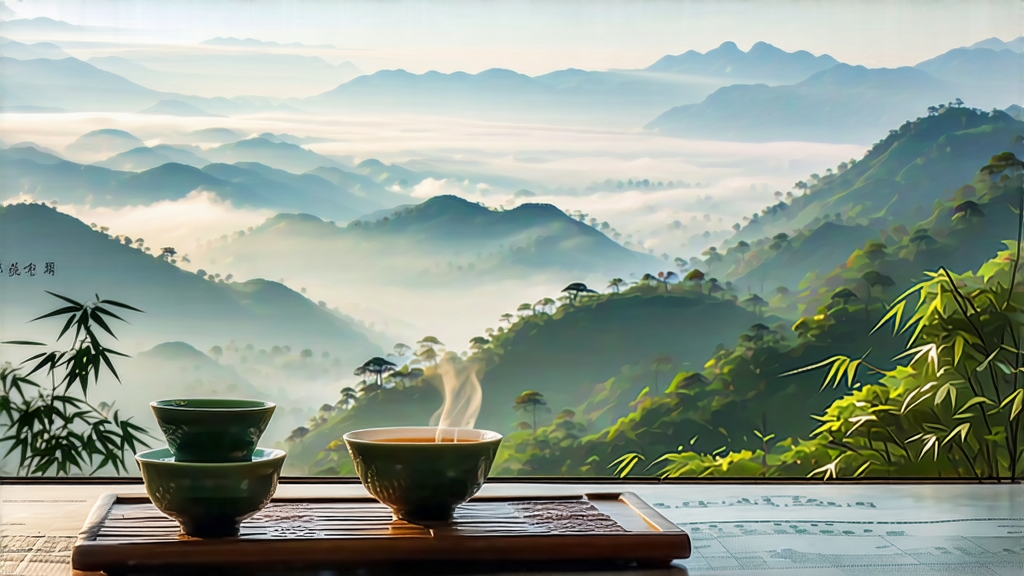
Alishan High-Mountain Oolong, known in Mandarin as “Alishan Qing Cha,” is one of Taiwan’s most celebrated gifts to the world of tea. Grown between 1,000 and 1,400 meters on the forested spine of the Alishan mountain range, this cultivar captures the island’s cool cloud forests in every curled leaf. International drinkers often meet it first through bubble-tea menus, yet the pristine, unblended spring harvest offers a far more nuanced story—one that begins with 19th-century Fujianese settlers, weaves through Japanese colonial agronomy, and ends in a modern competition culture that prizes tiny 100-gram lots selling for hundreds of dollars.
History and Terroir
When the Qing government opened Taiwan’s highlands to Han migrants in the 1820s, Fujianese farmers carried soft-stem cuttings of the Qing Xin (Green Heart) cultivar across the strait. They noticed that the mist-locked ridges of present-day Chiayi County slowed leaf growth, concentrating amino acids and volatiles. Under Japanese rule (1895-1945), agronomists established experimental stations, introducing scientific withering racks and standardized rolling machines. After 1980, government-sponsored “High-Mountain Tea” appellations protected elevation minimums, and Alishan became shorthand for the bright, milky fragrance that only a cloud-veiled terroir can create. Today, indigenous Tsou farmers work alongside fourth-generation Han families, sharing eco-certification premiums that keep pesticide residues below Japanese import limits.
Cultivar and Garden Cycle
Almost all authentic Alishan Oolong is Qing Xin; the cultivar’s thin cuticle and low polyphenol ratio translate into the famous “mountain qi” sweetness. Gardens are carved into terraces of decomposed granite mixed with cypress needles, creating acidic, fast-draining soils. Temperatures swing 12 °C between dawn and noon, prompting the plant to produce more geraniol and linalool—molecules responsible for orchid and lily notes. Farmers prune bushes to a waist-high “table” shape in winter; by late March, pale pink buds emerge, ready for the two-week spring picking window. A smaller autumn harvest follows in October, yielding a lighter cup with greener edges.
Plucking and Oxidation Craft
Standard protocol demands “one bud, three leaves” plucked at 8 a.m. when dew still weighs the sprig, lowering leaf temperature and delaying enzymatic browning. The harvest is placed in shallow bamboo trays and wheeled into a sunlit courtyard for 30 minutes of solar withering; UV light triggers grassy hexenal conversion into sweeter hexanol. Indoors, the leaf is tossed inside tumbling bamboo drums—150 rotations every hour for eight hours—bruising cell walls just enough to coax 20–25 % oxidation, the sweet spot between green tea’s grassiness and black tea’s malt. A brief 200 °C kill-green locks in the jade-green center while allowing the leaf margins to amber. Next comes the Taiwanese innovation of “cloth-ball rolling”: moist leaf is wrapped in cotton squares and compressed under a 70 kg stone roller for three minutes, released, then re-wrapped up to 60 times. This alternating pressure forms the characteristic hemispherical “dragon ball” shape while squeezing out tea oils that later glisten in the cup.
Roasting Spectrum
Alishan Oolong is sold along a roasting continuum. Modern “light roast” (qing xiang) versions are dried at 80 °C for 90 minutes, preserving bright lily and honeydew notes. Connoisseurs seeking depth request a traditional “soft roast” (wen huo): 100 °C for six hours, rested seven days, then repeated twice more, adding chestnut cream and toasted coconut layers without masking the high-mountain lift. A small cohort of charcoal artisans still bury leaf baskets in longan-wood embers overnight, turning the leaves every 20 minutes to avoid acrid smoke; the resulting “heavy roast” (zhong huo) can age for decades, evolving into prune, camphor, and sandalwood.
Water and Ware
To translate mountain mist into an international kitchen, begin with low-mineral water (TDS 30–60 ppm). A 120 ml white porcelain gaiwan offers thermal stability and visual contrast against the olive-green leaf. Pre-heat all vessels, then fill the gaiwan one-third full with 6 grams of loosely rolled pellets; they should clink like tiny marbles. Use 95 °